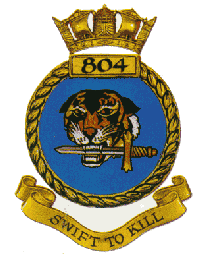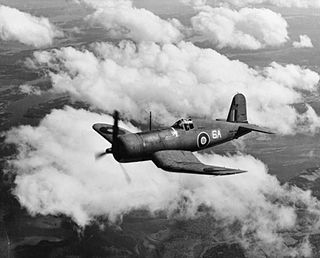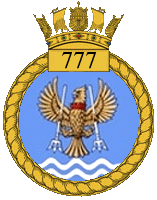
1790 Naval Air Squadron was a Fleet Air Arm (FAA) naval air squadron of the United Kingdom’s Royal Navy (RN). It was formed on 1 January 1945 at RNAS Burscough as a night fighter squadron. It was initially equipped with the Fairey Firefly I, replaced in May 1945 by the Firefly INF, which was fitted with a US-derived ASV radar. The squadron joined HMS Vindex on 24 June, bound for Australia, with the ship arriving at HMS Nabthorpe 2 days before the war in the Far East ended. The squadron was disbanded on 3 June 1946 at Devonport.

811 Naval Air Squadron was a unit of the British Royal Navy's Fleet Air Arm. It was first founded in 1933, and served during World War II, seeing action in the battle of the Atlantic and on Russian convoys, and was eventually disbanded in 1956.
835 Naval Air Squadron was a former squadron of the Royal Navy's Fleet Air Arm originally formed in February 1942 as a torpedo bomber and reconnaissance unit flying Fairey Swordfish. In June 1943, six Sea Hurricanes were added to the squadron as a fighter flight. The composite unit exchanged the Hurricanes in September 1944 for Grumman Wildcats, serving on until 1 April 1945, when the squadron disbanded.

804 Naval Air Squadron was a Fleet Air Arm (FAA) naval air squadron of the United Kingdom’s Royal Navy (RN), formed in November 1939 from part of 769 NAS Sea Gladiators which had been detached to RNAS Hatston. The squadron was merged into 800 NAS in June 1944 and subsequently reformed in September.
818 Naval Air Squadron was a Royal Navy Fleet Air Arm carrier-based squadron formed in August 1939. It served on a number of the Navy's aircraft carriers during the Second World War, serving in most of the theatres of the war, before decommissioning at the end of the war.
812 Naval Air Squadron was a Naval Air Squadron of the British Royal Navy's Fleet Air Arm. It was active between 1933 and 1956, and saw service in both World War II and the Korean War.

778 Naval Air Squadron was a Fleet Air Arm (FAA) naval air squadron of the United Kingdom’s Royal Navy (RN). During the Second World War the squadron was a Service Trials Unit (STU) initially based at HMS Daedalus, RNAS Lee-on-Solent, Hampshire, England before moving to HMS Condor, RNAS Arbroath, Angus, Scotland on 6 July 1940. The squadron tested all types of aircraft that could be used by the Royal Navy. Key to this was testing new types for deck landing on aircraft carriers. Such aircraft included various types of Supermarine Seafires, Grumman Hellcats, Grumman Martlets, Grumman Avengers, and Vought Corsairs. The squadron was reformed on 5 November 1951 with Douglas Skyraider AEW.1 but was disbanded on 7 July 1952 to form the basis of 849 Naval Air Squadron.

878 Naval Air Squadron was a Fleet Air Arm (FAA) naval air squadron of the United Kingdom’s Royal Navy (RN). Established in March 1943 as a fleet fighter squadron, it conducted its initial training at HMS Sparrowhawk, RNAS Hatston on Mainland, Orkney, prior to boarding HMS Illustrious in June. The squadron operated from the aircraft carrier off the coast of Iceland before delivering air support during the Salerno campaign in Italy. It ultimately disbanded at HMS Gannet, RNAS Eglinton, Northern Ireland in January 1944, with its aircraft being transferred to 816 and 1832 Naval Air Squadrons.

884 Naval Air Squadron was a Fleet Air Arm (FAA) naval air squadron of the United Kingdom’s Royal Navy (RN), which last disbanded in July 1943. It formed at HMS Merlin, RNAS Donibristle, as a Fleet Fighter squadron, in November 1941. The squadron supported RAF Fighter Command by offering fighter protection and engaged in various operations, including efforts to alleviate the Siege of Malta and the Allied invasion of French North Africa.

886 Naval Air Squadron was a Naval Air Squadron of the Royal Navy's Fleet Air Arm. It was formed at HMS Merlin, RNAS Donibristle, as a Fleet Fighter squadron during March 1942. The squadron was loaned to RAF Fighter Command during the summer of 1942, returning the Fleet Air Arm later on in the year. 1943 saw it participate in Operation Avalanche, part of the Allied invasion of Italy. The following year it was involved with operations over Normandy, spotting for the allied invasion of France from 6 to the end of June 1944, disbanding the following month.
896 Naval Air Squadron was a Fleet Air Arm (FAA) naval air squadron of the United Kingdom’s Royal Navy (RN). Established as a fighter squadron in September 1942, at Norfolk, Virginia, the squadron joined HMS Victorious in February 1943, heading to the Pacific. In May 1943, it conducted fighter operations over the Coral Sea and later supported United States Marines landings in the Solomons in June 1943, using Tontouta as a shore station. The squadron returned to the UK, in September, having re-equipped with Grumman Wildcat aircraft and joined the 7th Naval Fighter Wing in November. It embarked in HMS Pursuer in November and provided air cover for a convoy to Gibraltar in February 1944. In April, it offered air support for an attack on the battleship Tirpitz before being disbanded into 881 Naval Air Squadron in June.

897 Naval Air Squadron was a Fleet Air Arm (FAA) naval air squadron of the United Kingdom’s Royal Navy (RN). Established as a fighter squadron at HMS Blackcap, RNAS Stretton, on 1 August 1942, the squadron was disbanded into 801 and 880 Naval Air Squadrons on 3 September. It reformed at HMS Blackcap as a fighter unit on 1 December 1942. On August 4, the squadron joined HMS Unicorn and provided air support for Operation Avalanche, part of the Allied invasion of Italy, in September 1943. The squadron became part of the 3rd Naval Fighter Wing, focusing on tactical reconnaissance and bombardment spotting. It provided cover during the Operation Neptune, the Normandy landings, where it claimed a Messerschmidt Bf 109 and inflicted damage on a midget submarine. The squadron disbanded into 885 Naval Air Squadron on 15 July 1944.

732 Naval Air Squadron was a Fleet Air Arm (FAA) naval air squadron of the United Kingdom’s Royal Navy (RN). It was initially formed in 1943 from a requirement for an Operational Training Unit for United States trained FAA pilots flying Vought Corsair fighter-bomber aircraft, at RN Air Section Brunswick, USNAS Brunswick, Maine, United States, and disbanded during 1944. In 1945 it was reformed for a brief period, as a Night Fighter Training Squadron, operating out of HMS Nighhawk, RNAS Drem, East Lothian, Scotland. Notably equipped with six Avro Anson 'flying classrooms', amongst other aircraft.
735 Naval Air Squadron was a Fleet Air Arm (FAA) naval air squadron of the United Kingdom’s Royal Navy (RN). It was active from 1943 as an ASV Radar Training Unit. Forming at HMS Nightjar, at RNAS Inskip, Lancashire, in 1944 the squadron moved to HMS Ringtail, RNAS Burscough, also in Lancashire. Various flights from the squadron moved on to form other Naval Air Squadrons, with the squadron eventually disbanding in 1946.

757 Naval Air Squadron was a Fleet Air Arm (FAA) naval air squadron of the United Kingdom’s Royal Navy (RN). It was first formed as a Telegraphist Air Gunner Training Squadron in 1939, operating out of RNAS Worthy Down, but after three months it went into abeyance, only to reform again in the same role, at the same location, in 1941 and operating until 1942. It then reformed as a Fighter Pool Squadron & Operational Training Unit at RNAS Puttalam, in Sri Lanka, in 1943. After a brief spell at RNAMY Tambaram, in India, the squadron finally disbanded at RNAS Katukurunda, in Sri Lanka, at the beginning of 1946.

768 Naval Air Squadron was a Fleet Air Arm (FAA) naval air squadron of the United Kingdom’s Royal Navy (RN). It last disbanded at HMS Gannet, RNAS Eglinton, Northern Ireland, in March 1949, having been formed as a Deck Landing Control Officer Training Squadron, in December 1948, to ensure one American-style signal trained DLCO could be located at every FAA station. It first formed as part of the Deck Landing Training School at HMS Condor, RNAS Arbroath, in January 1941, as a Deck Landing Training Squadron. Advanced training was in HMS Argus, for which a detachment was maintained at HMS Landrail, RNAS Machrihanish, where it wholly moved to in March 1943. September saw a move to RAF Heathfield, Ayr, followed by a further move to HMS Sanderling, RNAS Abbotsinch in January 1944. Training used escort carriers on the Firth of Clyde and a detachment was maintained at (Heathfield)Ayr throughout this period, with the squadron returning there in July 1945, at this time HMS Wagtail, RNAS Ayr. In August the squadron moved to HMS Corncrake, RNAS Ballyhalbert in Northern Ireland but then in October it joined up with the Deck Landing School at HMS Peewit, RNAS East Haven, Scotland, where it disbanded in April 1946.

769 Naval Air Squadron was a Fleet Air Arm (FAA) naval air squadron of the United Kingdom’s Royal Navy (RN). It last disbanded and merged with 717 Naval Air Squadron after the Second World War. 769 Naval Air Squadron Formed at HMS Merlin, RNAS Donibristle, during May 1939, by renumbering 801 Naval Air Squadron. Its role was a fighter Deck Landing Training Squadron, using HMS Furious for advanced training, before disbanding in the December. It reformed in November 1941, as a unit within the Deck Landing Training School at HMS Condor, RNAS Arbroath, and in November 1943, it moved to HMS Peewit, RNAS East Haven. Its role changed to Torpedo Bomber Reconnaissance Training in 1944, before moving to HMS Merganser, RNAS Rattray, in July 1945.

777 Naval Air Squadron was a Fleet Air Arm (FAA) naval air squadron of the United Kingdom’s Royal Navy (RN), which formed as a Fleet Requirements Unit in West Africa during the Second World War. Throughout most of 1943, the squadron was responsible for the air defence of Sierra Leone. It disbanded at HMS Spurwing, RNAS Hastings, Sierra Leone, during December 1944. The squadron reformed in May 1945, from 'B' Flight of 778 Naval Air Squadron, as a Carrier Trials Unit operating aboard HMS Pretoria Castle, and using shore bases at HMS Siskin, RNAS Gosport, and HMS Peregrine, RNAS Ford in England, and HMS Wagtail, RNAS Ayr, in Scotland. 777 Naval Air Squadron number was assigned to the aircraft collection at the Fleet Air Arm Museum in April 2006.

784 Naval Air Squadron was a Fleet Air Arm (FAA) naval air squadron of the United Kingdom’s Royal Navy (RN) which last disbanded in the autumn of 1946. 784 NAS was a Night Fighter Training Squadron which formed at HMS Daedalus, RNAS Lee-on-Solent, Hampshire, in June 1942, moving to HMS Nighthawk, RNAS Drem, East Lothian, in October 1942. Squadron Personnel were also detached to the Naval Air Radio Installation Unit at RAF Christchurch, in 1943 and in the same year, a number of crews were attached to RAF night fighter squadrons, with two officers gained Distinguished Flying Crosses. In 1944, three squadron Flights were attached for service to each of 813, 825 and 835 Naval Air Squadrons, embarked in the escort carriers HMS Campania, HMS Vindex, and HMS Nairana respectively, on convoy protection duties. At the beginning of 1946 the squadron moved to Wales, operating out of HMS Goldcrest II, RNAS Brawdy.

1844 Naval Air Squadron was a Fleet Air Arm (FAA) naval air squadron of the United Kingdom’s Royal Navy (RN) between 1943 and 1945 and then a Royal Naval Volunteer Reserve Air Squadron from 1954 to 1957. It formed in Northern Ireland at HMS Gannet, RNAS Eglinton, in December 1943, as a fighter squadron. It embarked in HMS Begum, in February 1944, for the Far East, arriving in Ceylon, in June and joining HMS Indomitable the following month. August, September and October saw the squadron undertake photographic reconnaissance and provide fighter cover for the attacks on Indaroeng and Emmahaven in Sumatra, then on Sigli, followed by the Nicobar Islands respectively.














